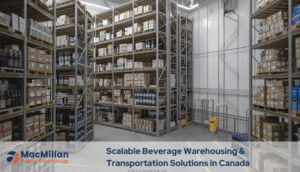Businesses approaches to supply chain management were drastically altered by the COVID-19 pandemic. Resilience and adaptability must now be given top priority in a system that was previously primarily built for efficiency. This change has increased the importance of effective risk management for businesses that depend on third-party logistics (3PL) providers.
We at MacMillan Supply Chain Group have seen directly how supply chain disruptions in Canada can affect companies of all sizes. The difficulties are numerous and frequently unforeseen, ranging from labor shortages to extreme weather events, from border closures to cybersecurity threats. For this reason, we have created thorough 3PL risk management plans that assist our clients in surviving disruptions and using them to their advantage.
Let’s examine how contemporary 3PL risk management practices are constructing more robust supply chains for Canadian companies and adjusting to post-pandemic realities.
Comprehending the New Risk Environment in Canadian Logistics
In recent years, supply chains’ risk environment has significantly grown. Traditional issues like inventory control and delays in transit are still significant, but new problems have surfaced that call for creative answers.
Changing Threat Trends
Disruptions to the Canadian supply chain can now take many different forms. Cross-border shipping can be seriously delayed by border restrictions between the USA and Canada. Transportation networks are frequently impacted by extreme weather events, such as floods in British Columbia and ice storms in Quebec. Meanwhile, since 2019, the number of cybersecurity threats aimed at logistics systems has grown by more than 300%, with ransomware attacks having the ability to completely stop operations.
The Interconnected Nature of Modern Risks
The interconnectedness of today’s challenges is what makes them especially challenging. Transportation compliance problems could result from a cybersecurity breach. Failures in cold-chain management could be brought on by a weather event. During peak seasons, e-commerce fulfillment capabilities may be impacted by labor shortages.
According to our Director of Operations, “the post-pandemic logistics environment requires thinking about risk in layers.” “Having a single backup plan is no longer sufficient; you need comprehensive strategies that address multiple potential failure points at the same time.”
Working with 3PL partners who comprehend global supply chain dynamics and the particular difficulties of conducting business in Canada’s varied geographic and regulatory environment is essential for Canadian companies. Diversification and strategic sourcing are now crucial elements of successful 3PL risk management.
 Technology-Driven Solutions for 3PL Risk Management and Supply Chain Resilience
Technology-Driven Solutions for 3PL Risk Management and Supply Chain Resilience
Modern logistics technology is now essential to 3PL risk management success. To improve supply chain resilience for our clients, MacMillan Supply Chain Group makes use of a number of important technologies.
AI-Powered Visibility in 3PL Risk Management
Your whole logistics network is visible in real time thanks to our AI-powered supply chain platforms. This technology anticipates possible disruptions before they affect your operations, in addition to tracking shipments. By analyzing weather patterns, traffic data, border crossing times, and historical performance metrics, our systems can recommend proactive adjustments to routing and scheduling.
For instance, our AI system automatically detected shipments that were at risk and recommended alternate routes when severe weather threatened deliveries throughout Ontario last winter, preventing delays for 94% of the impacted orders.This level of predictive control strengthens overall 3PL risk management capabilities.
Blockchain for Enhanced Security and Transparency
Blockchain has been incorporated into logistics processes for goods that need rigorous chain-of-custody documentation. This is especially helpful for food supply chains and pharmaceutical logistics, where product authenticity and temperature control are crucial.
Our Technology Director observes that “Blockchain provides an immutable record of every touchpoint in the supply chain.” “This improves security and streamlines compliance paperwork for international shipping between the United States and Canada.”
By adopting these technologies, we assist customers in creating resilient supply chains in Canada’s distinct and difficult logistics landscape, guaranteeing business continuity even in the face of interruptions. Together, these technologies form a core pillar of advanced 3PL risk management.
Strategic Sourcing and Relationship Management
Beyond technology, strategic sourcing and relationship management techniques that act as organic barriers against interruptions are also essential components of effective 3PL risk management.
Diversification as a Strategy for Risk Mitigation
We learned a valuable lesson from the pandemic: relying too much on a single supplier or transportation route can lead to dangerous vulnerabilities. At MacMillan Supply Chain Group, we assist customers in putting 3PL risk management-driven diversification plans into action that strike a balance between resilience and efficiency.
Maintaining connections with several carriers for every transportation lane and setting up warehouse capacity in various geographical areas are two examples of what this could entail. Creating options for LTL and TL shipping to handle different volumes. Making backup plans for different ports of entry for shipments coming from abroad.
“Strategic sourcing isn’t just about finding the lowest price,” explains our Supply Chain Director. “It’s about creating a network that can adapt when disruptions occur.”
Contractual Frameworks for 3PL Risk Management
Contemporary innovations in contracts have emerged as crucial instruments for risk management. We collaborate with clients to create contracts that contain the following: – Explicit force majeure provisions that cover pandemic situations. Metrics of performance that encourage proactive risk management. Provisions for managing tariffs on international shipping. Frameworks for shared responsibility regarding cybersecurity threats.
We assist clients in developing supply chains that continue to function even in the event of disruptions to individual components by fusing strategic diversification with strong contractual frameworks. For Canadian companies negotiating the challenging post-pandemic logistics environment, this strategy has proven especially helpful. This layered approach to contracts plays a central role in our overall 3PL risk management model.
Industry-Specific Risk Management Approaches
Supply chain issues vary by industry, necessitating customized 3PL risk management techniques. We at MacMillan Supply Chain Group have created specialized strategies for a number of important industries.
Medicine and Healthcare
Maintaining product integrity throughout the supply chain is a non-negotiable requirement for pharmaceutical logistics. Our approach to risk management consists of: Cold chain management systems that are redundant and have backup power sources. Temperature tracking with blockchain verification and real-time alerts. Expert contingency preparation for urgent medical shipments. Management of compliance documentation for products under regulation.
Last year, a significant power outage threatened a vital vaccine shipment, but our backup systems kept the temperature stable the entire time, saving $2.3 million worth of product value.
E-commerce and Retail
Peak season capacity and delivery dependability pose serious problems for e-commerce fulfillment operations. Our strategy consists of: – Expandable warehouse space with staff cross-training initiatives – Diversified last-mile delivery alliances to avoid bottlenecks. AI-based inventory positioning techniques. Demand forecasting that is driven; automated systems with manual backup procedures for essential operations.
This is where agile and tech-driven 3PL risk management becomes essential. Our E-commerce Director observes that “the holiday season tests every aspect of your risk management strategy.” “We plan months ahead of time, incorporating redundancy into every stage of the fulfillment process.”
We assist clients in addressing their particular vulnerabilities while preserving the adaptability to handle unforeseen difficulties in the post-pandemic logistics environment by creating industry-specific risk management procedures.
 Common Challenges in 3PL Risk Management
Common Challenges in 3PL Risk Management
Despite their best efforts, many companies find it difficult to work with their 3PL partners to implement efficient risk management strategies. We’ve noticed the following frequent difficulties:
Planning Is More Reactive Than Proactive
A lot of companies don’t start thinking about risk management until after something goes wrong. Businesses are left vulnerable by this reactive approach, which usually leads to higher recovery costs. Even small disruptions have the potential to spiral into significant operational failures in the absence of proactive contingency planning.
Visibility Challenges in 3PL Risk Management
Low visibility is still a major problem. Real-time information about shipment status, inventory positions, and possible disruptions is lacking in many businesses. Particularly in complex supply chains with several modes of transportation or cross-border shipping between Canada and the USA, this information gap makes it impossible to react promptly when issues emerge.
Inadequate Contractual Protections
Older contracts frequently don’t have the clauses needed to handle the risks of the modern supply chain. When force majeure clauses failed to cover the unprecedented disruptions during the pandemic, many businesses learned this lesson. Determining who is responsible for disruptions becomes difficult and time-consuming in the absence of clear contractual frameworks.
The Difficulties of Technology Integration
Although sophisticated logistics technology provides strong risk management capabilities, efficacy is frequently constrained by integration issues. Data silos produced by disconnected systems hinder thorough risk assessment and response. For companies that use several 3PL providers without standardized data sharing protocols, this is especially problematic.
Cost Concerns Overriding Resilience Needs
Perhaps most fundamentally, when choosing 3PL partners, many organizations continue to place a higher priority on cost reduction than resilience. As the true cost of ineffective 3PL risk management becomes evident, this short-term strategy frequently results in higher costs when disruptions unavoidably occur.
MacMillan’s All-Inclusive 3PL Risk Management Solutions
To solve these typical problems, we at MacMillan Supply Chain Group have created a multi-layered strategy that offers our clients genuinely robust 3PL risk management solutions.
A proactive approach to risk assessment and planning
Every client relationship starts with a thorough risk assessment that finds possible weak points in your supply chain. This procedure looks at:
Risks of geographic concentration in your networks of suppliers and distributors – Requirements for transportation compliance in all applicable jurisdictions. Cybersecurity risks unique to your business and operations. Seasonal capacity issues and patterns of disruption in the past. Cross-border shipping regulations and tariff management considerations.
We create tailored backup plans for different disruption scenarios based on this assessment. These are comprehensive response protocols that are adapted to your unique business requirements and risk profile rather than being generic templates.
Our Risk Management Director says, “We regularly simulate disruptions with our clients.” “This procedure guarantees that everyone is fully aware of what to do in the event that actual difficulties emerge.”
End-to-end Visibility Using Integrated Technology
For your whole supply chain, our technology platform offers a single source of truth. This comprehensive strategy incorporates:
Inventory visibility across several warehouse locations; real-time shipment tracking across all modes of transportation; predictive analytics for early disruption detection; and automated alert systems for possible compliance issues. Blockchain validation for valuable or sensitive shipments.
Proactive risk management and quick reaction to interruptions are made possible by this thorough visibility. Our AI-powered supply chain solutions keep an eye out for possible problems all the time, enabling us to fix them before they affect your business operations.
Designing Strategic Networks for Resilience
We assist customers in creating logistics networks that strike a balance between robustness and efficiency. This method of strategic sourcing consists of:
Multi-region warehouse capacity with inventory positioning strategies
Carrier diversification across all critical transportation lanes
Flexible capacity arrangements for seasonal demand fluctuations
Alternative routing options for international and cross-border shipments
For example, we helped a Canadian retailer establish a distributed fulfillment network that maintained 99.7% order fulfillment during recent port congestion issues that severely impacted competitors.
Concurrent Contractual Structures
Our innovations in contracts offer precise rules for handling interruptions. Among these agreements are:
Resilience incentives combined with comprehensive performance metrics. Particular clauses on force majeure that address contemporary risk situations. Protocols for cooperative problem-solving for unforeseen obstacles. Clear cost-sharing structures for exceptional situations.
Excellence in Cold Chain
Our cold-chain management solutions, which include redundant systems, continuous monitoring, and rapid response protocols, have maintained 100% compliance rates for temperature-sensitive products—even during severe weather events and power outages.
We offer our clients genuinely resilient logistics operations that can withstand the difficulties of the post-pandemic business environment by thoroughly addressing every facet of supply chain risk.
 Developing a Resilient 3PL Risk Management Strategy
Developing a Resilient 3PL Risk Management Strategy
Although putting in place efficient 3PL risk management takes time, there are doable actions you can take right now to start bolstering the resilience of your supply chain in Canada’s demanding logistics landscape.
Begin with a 3PL Risk Management Assessment
Start by determining your biggest weaknesses. Which goods, vendors, or routes of transportation would be most affected if they were compromised? What single points of failure do you have? Prior to putting solutions in place, it is crucial to comprehend your current risk profile.
Evaluate Your Technology Infrastructure
Determine whether the visibility and predictive power required for efficient risk management are offered by your current systems. Is it possible to track shipments in real time? Are you notified in advance of any impending disruptions? If not, updating your technology might be your top priority.
Examine Your Contractual Rights
Look over your existing 3PL contracts to find any areas where risk coverage is lacking. Are contemporary threats like cybersecurity breaches covered by your contracts? Are provisions for force majeure sufficiently specific to address different types of disruptions? Your risk position can be considerably improved by updating these agreements.
Partner With MacMillan Supply Chain Group
Working with MacMillan Supply Chain Group provides the quickest route to complete protection for companies that are serious about creating a truly resilient supply chain. Our team has decades of experience implementing successful risk management strategies and navigating supply chain disruptions in Canada.
For a free risk assessment and to learn how our third-party logistics solutions can support your company’s success even in the face of unforeseen obstacles, get in touch with us today. To speak with a supply chain resilience specialist, visit our website or give us a call at 416-941-2759.
Follow us on LinkedIn for real-time tariff updates
FAQS
3PL risk management is the systematic process of identifying, assessing, and mitigating potential disruptions in third-party logistics operations. This includes developing strategies to address transportation delays, inventory shortages, cybersecurity threats, compliance issues, and other challenges that could impact your supply chain. Effective 3PL risk management combines technology, strategic planning, and operational flexibility to ensure business continuity.
Post-pandemic logistics has evolved to place greater emphasis on resilience over pure efficiency. Key changes include more diversified supplier and carrier networks, increased investment in visibility technology, more comprehensive contractual protections, and greater attention to scenario planning. The pandemic also highlighted the importance of flexibility in capacity management and the value of strategic inventory positioning.
Canadian supply chain disruptions commonly stem from border crossing delays, extreme weather events, labor shortages, and cybersecurity threats. Additionally, the country's vast geography creates unique challenges for maintaining consistent service levels across different regions, particularly for cold-chain management during winter months.
Advanced logistics technology provides real-time visibility, predictive analytics, and automated response capabilities. AI-driven supply chain tools can identify potential disruptions before they impact operations, while blockchain in logistics creates secure, immutable records for sensitive shipments. These technologies enable both proactive risk mitigation and faster recovery when disruptions occur.
Look for 3PLs with comprehensive risk assessment processes, documented contingency plans, robust technology platforms, and a track record of successful crisis management. Ask about their approach to cybersecurity threats, their carrier diversification strategy, and their experience with your specific industry challenges. Also evaluate their transportation compliance expertise, particularly for cross-border shipping.
Modern contractual innovations are essential for effective risk management. Look for clearly defined force majeure clauses, specific performance metrics related to risk management, and collaborative problem-solving protocols. The best agreements balance responsibility appropriately between parties and provide clear guidelines for managing various disruption scenarios.
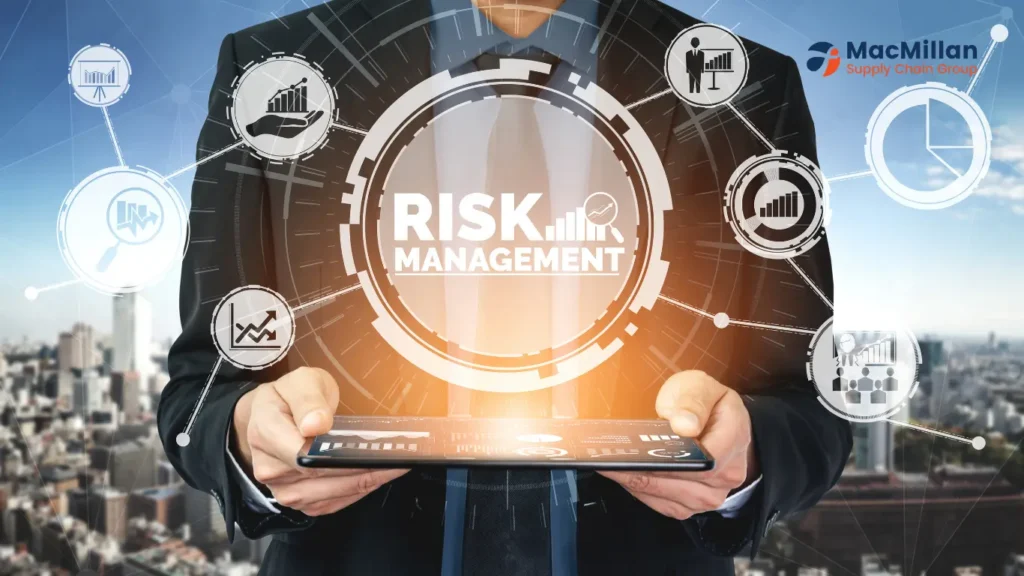
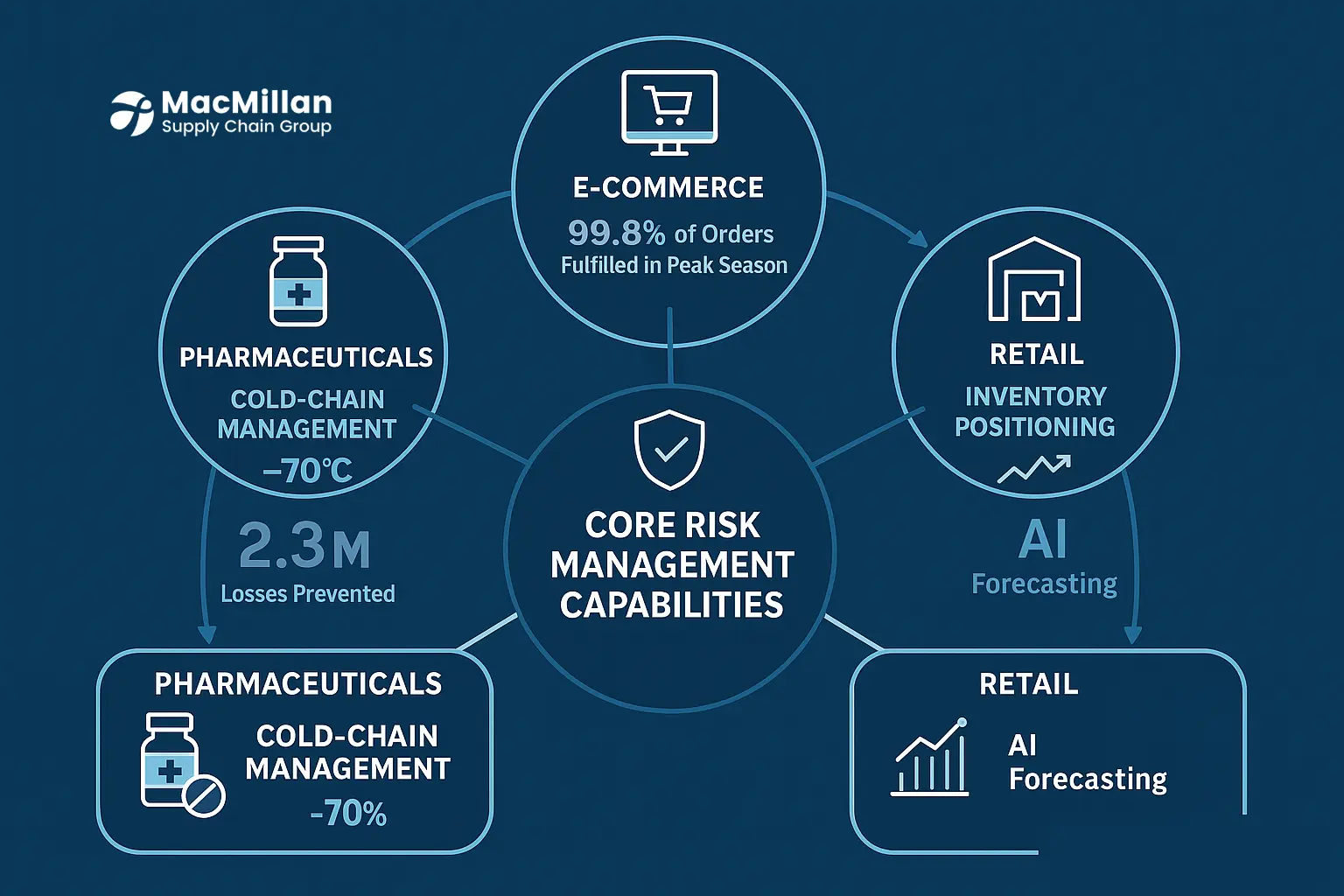 Technology-Driven Solutions for 3PL Risk Management and Supply Chain Resilience
Technology-Driven Solutions for 3PL Risk Management and Supply Chain Resilience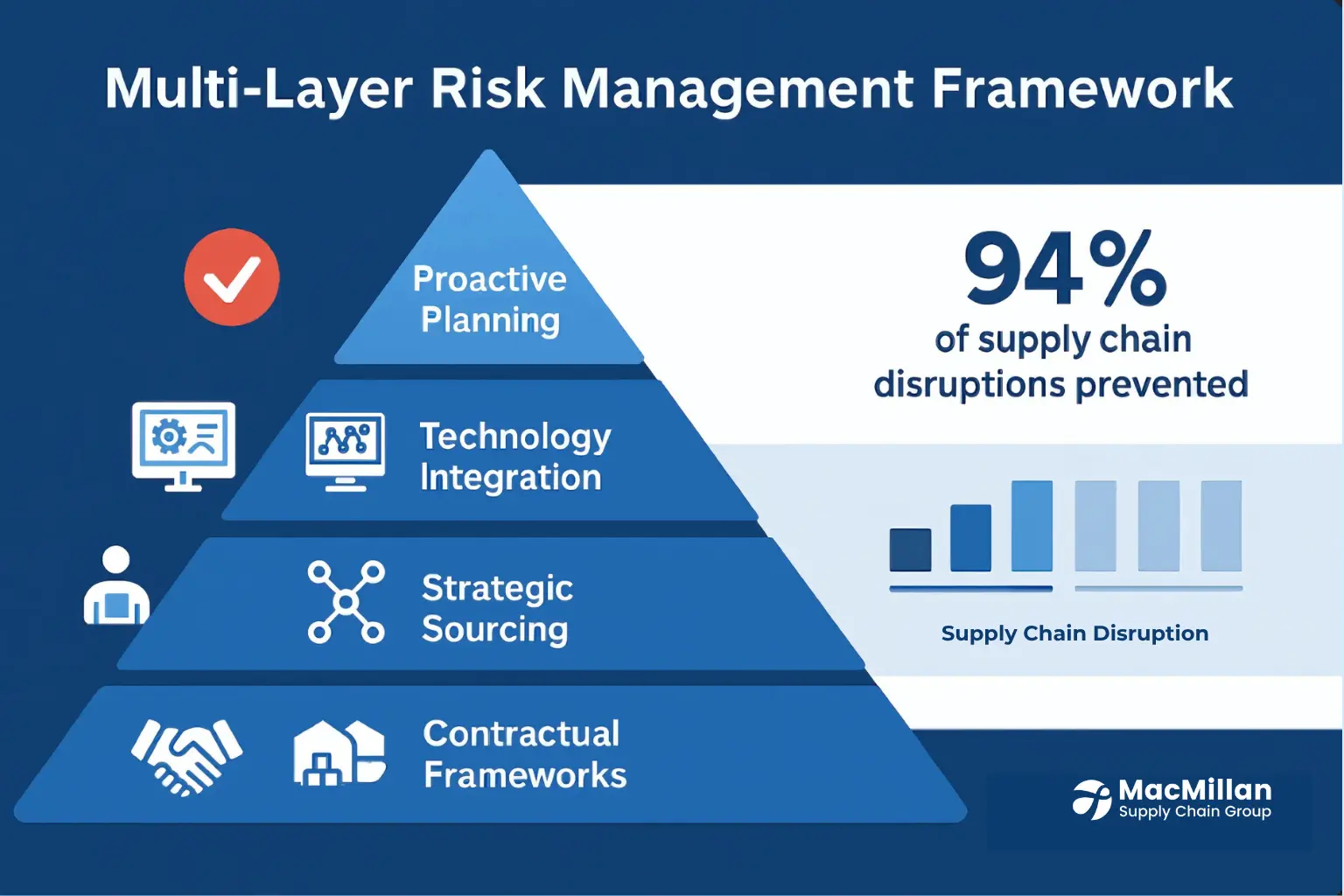 Common Challenges in 3PL Risk Management
Common Challenges in 3PL Risk Management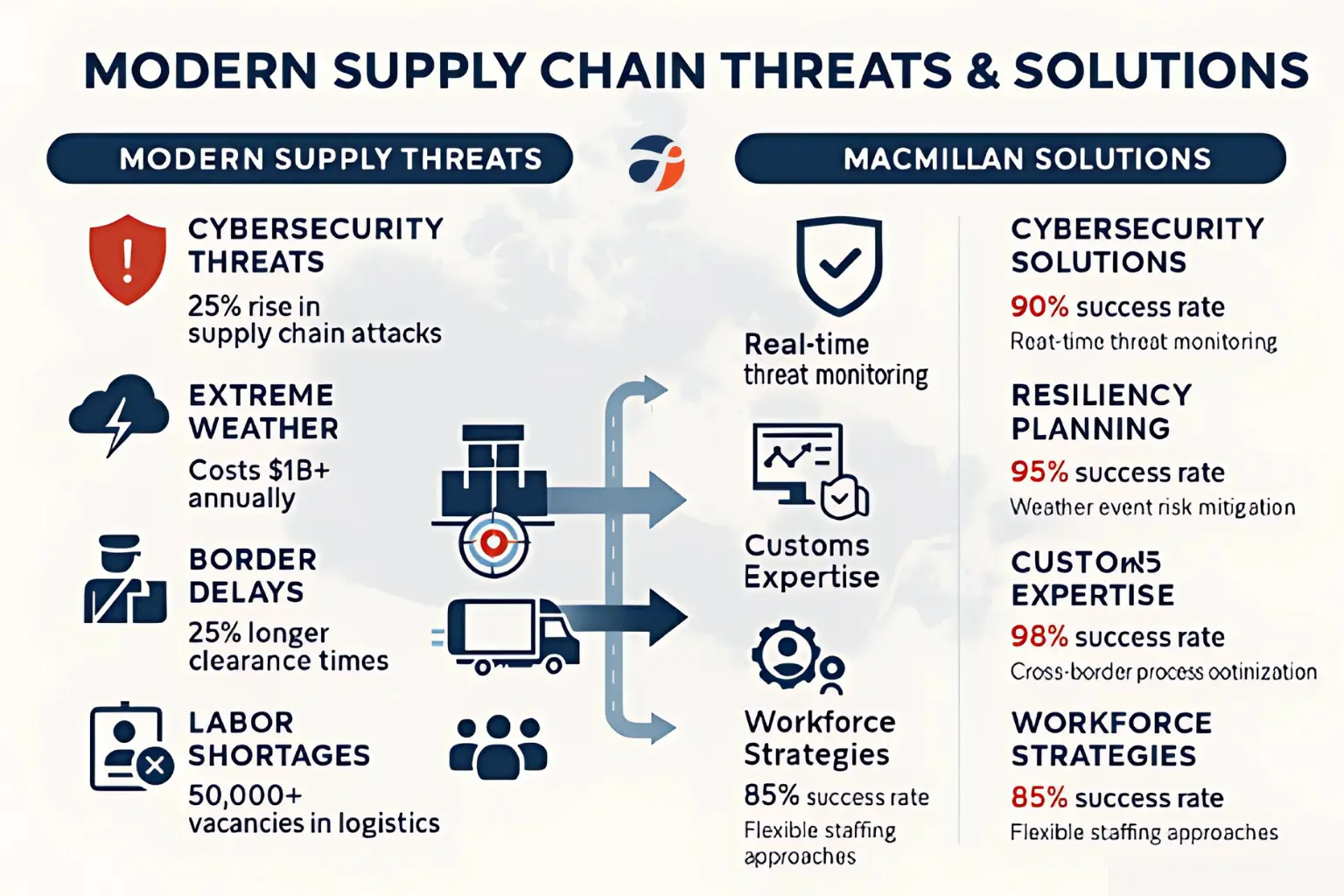 Developing a Resilient 3PL Risk Management Strategy
Developing a Resilient 3PL Risk Management Strategy